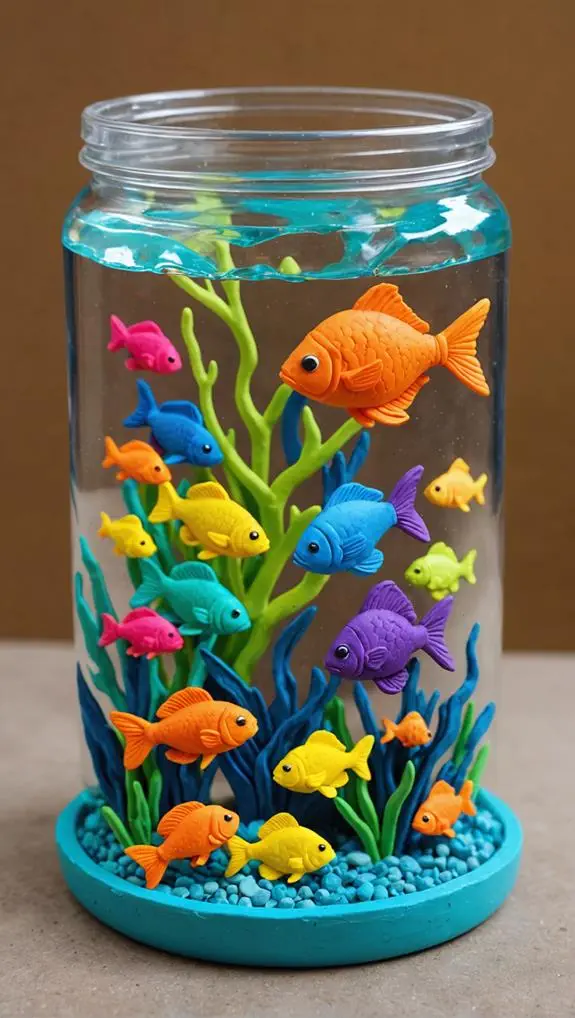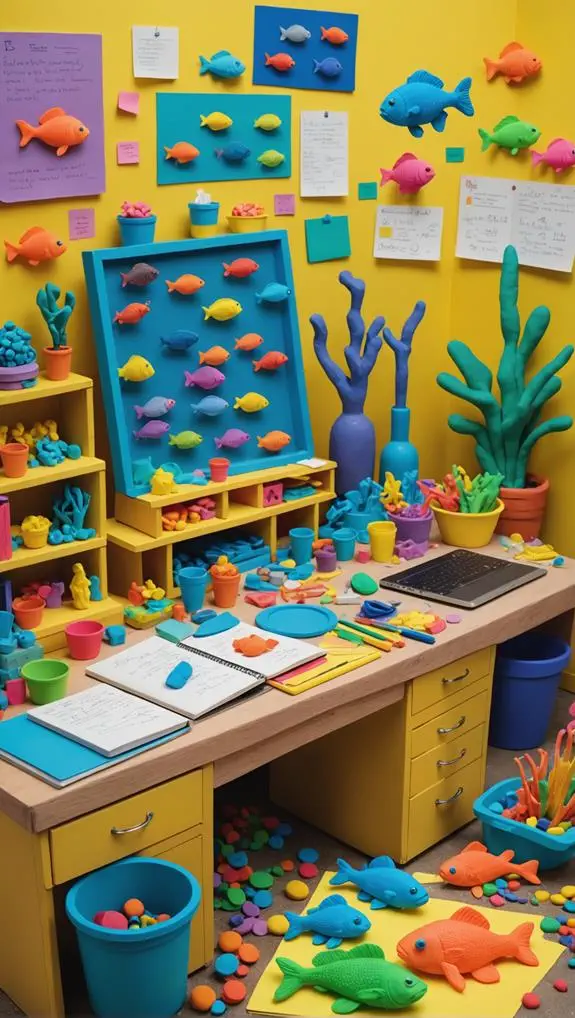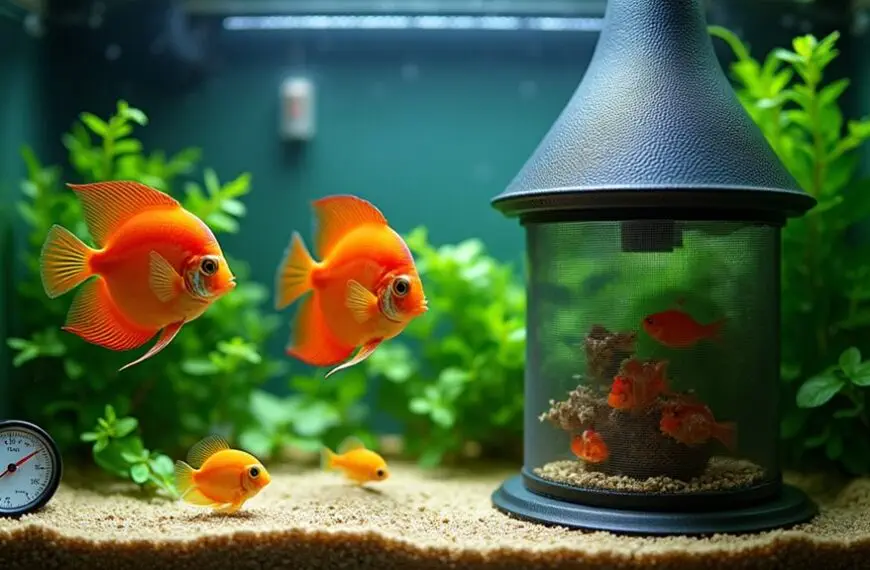When you're diving into freshwater fish breeding, steer clear of some common mistakes that can quickly derail your efforts. First, never underestimate the importance of water quality; keeping pH and oxygen levels just right is key. Overcrowding is another biggie—too many fish can cause stress and disease. Don't overfeed either; excess waste is a disaster for water conditions. Plus, always prioritize disease prevention—keeping everything clean can save you a lot of heartache! Lastly, don't skip record keeping; tracking growth and health will smooth your journey to successful breeding. Stick around, and you'll find even more helpful tips!
Contents
Overlooking Water Quality Management
When it comes to breeding freshwater fish, overlooking water quality management can spell disaster for your efforts. You wouldn't want to serve your fish a toxic cocktail, right? That's why monitoring parameters like pH, dissolved oxygen, and temperature is crucial. Aim for a pH between 6.5 and 9.0 for optimal health.
Additionally, testing for ammonia and nitrite levels is essential since they must remain at 0 ppm to prevent toxicity. And don't forget about dissolved oxygen! Keeping it above 5 mg/L helps your fish thrive without stress.
To keep things swimming smoothly, invest in good filtration systems and aeration. These tools not only help maintain water clarity but also reduce the risk of disease. You know what they say—happy fish mean happy breeders!
Regular water testing for contaminants and nutrients is a must. Think of it as a health check-up for your fish. Schedule these tests to catch any issues before they become a problem, as monitoring key parameters weekly enables corrective actions to maintain optimal conditions.
Plus, it's a great excuse to show off your dedication to your aquatic friends! So, roll up your sleeves, dive into the world of water management, and give your fish the best environment possible. After all, a little effort goes a long way in making your breeding journey successful and fulfilling!
Overstocking Fish Populations
Overstocking fish populations can quickly turn your breeding project into a nightmare. Imagine your fish struggling for oxygen as they compete for space like kids in a crowded playground. High stocking density can lead to oxygen levels dropping below that crucial 5 mg/L mark. When this happens, your fish's health and growth can take a serious hit.
Maintaining optimal water quality is essential for fostering a healthy breeding environment, as poor conditions can exacerbate stress and lead to increased mortality rates. As a general rule, aim for at least 1 inch of fish per gallon of water, but keep in mind that this can vary based on species and growth rates.
If you squeeze too many fish into one tank, stress levels soar, and your fish become more prone to diseases. In fact, overstocking can reduce survival rates by up to 50%!
And let's not forget about water quality. Too much fish biomass can lead to ammonia and nitrite buildup, making your tank a toxic environment.
Keeping fish populations optimal not only protects their health but also improves feed conversion ratios. You'll find they grow more efficiently, needing only 1.5 to 2 pounds of feed for each pound of fish.
Improper Feeding Practices

Feeding your fish properly is crucial for their growth and overall health. We all want our aquatic friends to thrive, right? So, let's avoid the common pitfall of improper feeding practices. Overfeeding might seem like a way to show love, but it can lead to a big mess—literally! Excess waste can harm water quality and create ammonia spikes, which aren't good for anyone.
Maintaining proper water parameters is essential to ensure a healthy environment for your fish, as toxic substances can lead to stress and illness.
Stick to fish feeding schedules that are consistent to keep your fish calm and happy. A routine not only helps with their feeding patterns but also boosts growth rates.
Don't forget to choose high-quality feed designed for your fish's specific species and life stage. Using the wrong food can cause nutritional deficiencies that stunt growth and lead to health issues.
Lastly, keep an eye on your fish. If they're acting weird or growing slowly, it might be time to reassess their diet. Understanding feed conversion ratios is also key; high FCR values mean you're wasting money on poor feed.
Neglecting Disease Prevention
Neglecting disease prevention can spell disaster for your fish breeding efforts. If you want your fish to thrive, you've got to prioritize health. Implementing solid biosecurity measures can reduce disease outbreaks by up to 90%, which is a huge win for both your fish and your productivity.
Regular health inspections are key; they can catch early symptoms of illness, boosting survival rates by around 30%. Who wouldn't want that?
You also need to keep your equipment and facilities sanitized. Cross-contamination can lead to a staggering 50% increase in disease transmission among your fish stocks. So, keep things clean, folks!
And don't forget about vaccination strategies. Vaccinating your fish against preventable diseases can cut mortality rates by roughly 40%. That's a lifesaver, literally!
Lastly, make sure you document your fish's health and disease history. This helps you manage your breeding stock better, leading to informed decisions that can enhance herd resilience.
Inadequate Record Keeping

Many fish breeders underestimate the importance of keeping accurate records, and that can lead to significant setbacks in their operations. Without proper data management, you might miss crucial details about fish growth rates, making it tough to optimize your breeding program.
Imagine trying to catch a fish without a fishing rod—frustrating, right?
Failing to document water quality parameters, like pH and dissolved oxygen levels, can result in problems that affect fish health and breeding success. Keeping breeding logs isn't just a chore; it's your safety net!
You'll also want to track the health history of your fish stocks. Without this, you might find yourself facing the same disease outbreaks over and over—talk about a fishy situation!
And don't forget about finances! Without detailed records, you'll struggle to analyze profitability, potentially leading to poor budgeting decisions.
Lastly, neglecting to document breeding stock lineage can compromise your selective breeding efforts. You want future generations to have the best traits, right?
Frequently Asked Questions
What Are the 3 Most Serious Problems Involved in Fish Farming?
In fish farming, you'll face serious problems like poor water quality, which stresses fish, inadequate disease management that leads to outbreaks, and overstocking, which can compromise both fish health and your farming success.
What Are the Problems With Breeding Fish?
You might think breeding fish is straightforward, but breeding challenges arise from health issues, inadequate water quality, and improper nutrition. Addressing these factors is vital to ensure your fish thrive and your efforts succeed.
What Is the Most Common Mistake in the Preparation of Fish?
In preparing fish, you often overlook water quality and tank size. Neglecting these factors can lead to poor growth and health issues. Prioritizing proper conditions ensures your fish thrive, allowing you to better serve your community.
What to Do When Fish Keep Breeding?
When fish keep breeding, focus on effective breeding management. Adjust tank conditions by controlling population density, selling or culling excess stock, and ensuring optimal environments to maintain fish health and prevent overstocking-related issues.
Final Thoughts
So, as you dive into the world of freshwater fish breeding, remember to keep an eye on those water conditions, avoid cramming too many fish in one spot, and feed them right. Don't forget to check for any sneaky diseases and jot down your progress. It's a lot to juggle, but with a little care and attention, you'll create a thriving underwater community. Who knows? You might just become the next fish whisperer! Happy breeding!












